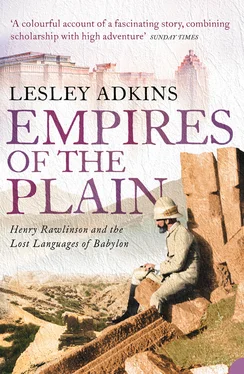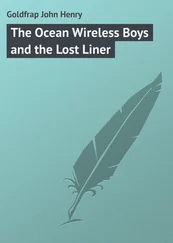After Alexander the Great, the Persian Empire came under Hellenistic Greek rule, until it was conquered a century later by the Parthians, nomads from central Asia, around 238 BC. The Parthians and their empire survived for more than four centuries, before being overthrown in AD 224 by the Sasanians under their first king Ardashir. It was the son of Ardashir, King Shapur I, who built the city of Bishapur that Rawlinson visited in 1834 while staying at Shiraz. The Sasanian Empire also lasted over four centuries until the Islamic conquest of Persia in AD 651.
Just before his trip to Bishapur, Rawlinson had visited the ruins of Persepolis and seen for the first time trilingual cuneiform inscriptions carved in the three scripts of Old Persian, Babylonian and Elamite, but at this stage he had no idea of their significance. The obsession of the Persian kings for inscriptions carved in three languages on rock faces and buildings ensured that those inscriptions remained visible to early European travellers, whereas most inscriptions in Mesopotamia were hidden from view, awaiting discovery in archaeological excavations. Because Europeans had greater contact with Persia at an earlier date than with Mesopotamia, it was inevitable that attempts at deciphering cuneiform began here, most notably at the ruins of Persepolis. Old Persian became crucial in understanding all other cuneiform scripts, and when Rawlinson achieved his first breakthrough in the decipherment of cuneiform, it was Old Persian that was to provide the first clues.
Over two centuries before Rawlinson arrived in Persia, European courts had been attempting to establish trading links with Shah Abbas I, and while on a mission to the Persian court on behalf of Philip III of Spain and Portugal, Antonio de Gouvea visited Persepolis in 1602. He found the writing of the inscriptions very strange: ‘there is no one who can understand it, because the characters are neither Persian, Arabic, Armenian, nor Hebrew, the languages now in use in the district.’ 1 Back at the Spanish court, Antonio de Gouvea met Don Garcia Silva Figueroa, who was himself inspired to visit the site in 1618 when in Persia as ambassador. Don Garcia was the first person to identify the ruins as Persepolis, but was equally puzzled by the sight of the inscriptions: ‘The letters themselves are neither Chaldaean, nor Hebrew, nor Greeke nor Arabike, nor of any other Nation which was ever found of old, or at this day to be extant. They are all three cornered, but somewhat long, of the forme of a Pyramide, or such a little Obeliske as I have set in the margin.’ 2
Pietro della Valle, a traveller from Rome, became acquainted with Don Garcia at Isfahan, and when della Valle left the city towards the end of 1621, he spent two days at Persepolis and the neighbouring ruins. Like Don Garcia, he noted: ‘One cannot tell in what language or letters these inscriptions are written, because the characters are unknown.’ 3 He was unsure of the direction of writing, ‘whether the characters are written from right to left as is the Oriental custom, or the opposite, from left to right as with us’, 4 but because of the way the signs were constructed, he correctly deduced from left to right. He copied five of the most common cuneiform signs, and even though publication of the account of his journey was delayed until 1658, these were still the first cuneiform signs ever to be published.
Dutch, English, French and German travellers and artists were in turn drawn to Persepolis, many publishing engravings of the inscriptions, although these were often inaccurate. Samuel Flower, an agent of the East India Company, copied several trilingual inscriptions, from which a random selection of twenty-three cuneiform signs from the three scripts, each one divided by a full-stop, was published in 1693. Scholars were misled into believing that this random selection represented a full inscription with punctuation, a confusion that lasted for over one hundred years. Thomas Hyde, a Professor of Hebrew and Arabic at Oxford, studied Flower’s so-called inscription and wrote in 1700 that the signs were purely decorative and could not represent writing, not least because they were all different and divided by full-stops. Although led astray by this composite inscription, he described the signs as ductuli pyramidales seu cuneiformes , so coining the term ‘cuneiform’.
The next significant advance was by Carsten Niebuhr, a Danish scholar and explorer who spent several days at Persepolis in 1765. When the account of his travels was published a few years later, his drawings of inscriptions at last provided reliable material for scholars to use in their attempts at decipherment. Niebuhr was the first to realize that the inscriptions comprised three different scripts and therefore probably three different languages. He misleadingly referred to each script as an alphabet, although only the Old Persian was an alphabet. Referring to the scripts as classes I, II and III, he thought that class I (recognized later as Old Persian) was more simple than the other two and had forty-two alphabetical signs (there are actually even fewer – thirty-six). He confirmed della Valle’s view that the writing was done from left to right, after observing that in two identical inscriptions the line endings were not in the same position. It did not seem to occur to Niebuhr that the three different scripts each reproduced the identical text.
Two decades later, in 1798, Oluf Gerhard Tychsen, a Professor of Oriental Languages at Rostock, published a paper wrongly alleging that the inscriptions at Persepolis were of Parthian date and claiming to make out the name of the first Parthian King, Arsaces (‘Aksak’), in a recurring group of signs. He did correctly identify one diagonal sign in the Old Persian script as a word divider, although he was incorrect to claim it could also signify the conjunction ‘and’.
That same year Frederik Münter, a Professor of Theology at Copenhagen, read two papers to the Royal Danish Society of Sciences that were published in 1800 (and translated into German in 1802). In his opinion the ruins and inscriptions could only belong to the Achaemenid kings, and among his many observations on the inscriptions he correctly concluded that the diagonal sign was only ever a word divider. He rejected Tychsen’s reading of the name Aksak and rightly suggested that it might be a Persian title, such as ‘king of kings’. However, he incorrectly suggested that the languages of the three scripts were Avestan (or Zend as it was then called), Pahlavi and Parsi.
The known languages of Persia are divided into Old Iranian (in use up to Alexander the Great’s conquest), Middle Iranian (used up to the Islamic conquest) and New Iranian. The Iranian language belongs to the Indo-Iranian branch of Indo-European languages, and around 1000 BC Iranian speakers spread from central Asia into Afghanistan and Persia (Iran). Old Iranian comprised two known languages, Old Persian and Avestan, and the former was the everyday speech of the Achaemenid kings and was probably the spoken language of south-west Persia. It is represented by a limited number of cuneiform inscriptions, as at Bisitun and Persepolis. At the same time, Avestan was spoken in north-east Persia and became the language used to compose the Avesta or Zend-Avesta, the holy texts of Zoroastrianism that became the state religion from the time of Cyrus the Great. The Avesta was originally handed down from one generation to another by word of mouth, but was written down for the first time in the Sasanian era, probably in the sixth century AD, long after cuneiform had gone out of use. The earliest surviving manuscripts date from the thirteenth century, just as most Latin texts from the Roman Empire survive only as medieval copies.
Читать дальше












